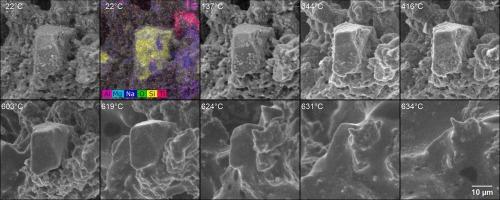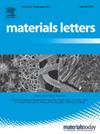模拟核废料进料转化为玻璃过程中瞬时相形成的高温环境扫描电子显微镜表征
IF 2.7
4区 材料科学
Q3 MATERIALS SCIENCE, MULTIDISCIPLINARY
引用次数: 0
摘要
现场高温环境扫描电子显微镜(HT-ESEM)用于表征代表模拟核废料进料的复杂玻璃批量混合物熔化过程中形成的瞬态相。首先出现的现象是氧阴离子盐熔体的形成,随后氧阴离子盐与含硅、铝或镁的耐火晶粒通过表面反应形成熔融碱-铝-硼-硅酸盐相。通过 HT-ESEM 测量直接确定了气泡形成和原生发泡的起始温度。此外,还直接观测并确定了硫酸盐湖的形成以及漂浮在样品表面的高温瞬态相的形成。还观察到了对流,并讨论了其对玻璃均质化的影响。本文章由计算机程序翻译,如有差异,请以英文原文为准。

High temperature environmental scanning electron microscopy characterization of transient phase formation during conversion of simulated nuclear waste feed to glass
In-situ High-Temperature Environmental Scanning Electron Microscopy (HT-ESEM) is used to characterize the transient phases formed during the melting of complex glass batch mixtures representing simulated nuclear waste feeds. The first phenomenon that occurs is the formation of oxyanionic salt melt, followed by the reaction of oxyanionic salts with refractory grains containing Si, Al, or Mg through surface reactions to form a molten alkali-alumino-boro-silicate phase. The onset temperatures of gas bubble formation and primary foaming are directly determined from the HT-ESEM measurements. The formation of sulfate lakes as well as the formation of high-temperature transient phases floating at the sample surface are also directly observed and identified. Convection currents are observed and their consequences on glass homogenization are discussed.
求助全文
通过发布文献求助,成功后即可免费获取论文全文。
去求助
来源期刊

Materials Letters
工程技术-材料科学:综合
CiteScore
5.60
自引率
3.30%
发文量
1948
审稿时长
50 days
期刊介绍:
Materials Letters has an open access mirror journal Materials Letters: X, sharing the same aims and scope, editorial team, submission system and rigorous peer review.
Materials Letters is dedicated to publishing novel, cutting edge reports of broad interest to the materials community. The journal provides a forum for materials scientists and engineers, physicists, and chemists to rapidly communicate on the most important topics in the field of materials.
Contributions include, but are not limited to, a variety of topics such as:
• Materials - Metals and alloys, amorphous solids, ceramics, composites, polymers, semiconductors
• Applications - Structural, opto-electronic, magnetic, medical, MEMS, sensors, smart
• Characterization - Analytical, microscopy, scanning probes, nanoscopic, optical, electrical, magnetic, acoustic, spectroscopic, diffraction
• Novel Materials - Micro and nanostructures (nanowires, nanotubes, nanoparticles), nanocomposites, thin films, superlattices, quantum dots.
• Processing - Crystal growth, thin film processing, sol-gel processing, mechanical processing, assembly, nanocrystalline processing.
• Properties - Mechanical, magnetic, optical, electrical, ferroelectric, thermal, interfacial, transport, thermodynamic
• Synthesis - Quenching, solid state, solidification, solution synthesis, vapor deposition, high pressure, explosive
 求助内容:
求助内容: 应助结果提醒方式:
应助结果提醒方式:


